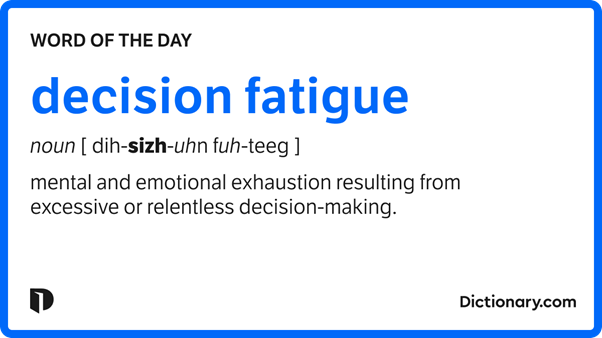
How to Overcome Decision Fatigue in Complex Supply Chains?
It’s 2 PM on a Tuesday, and your supply chain team has already made 47 decisions since morning. Vendor selection, inventory allocation, route optimisation, supplier negotiations – the choices never stop. By afternoon, even simple decisions feel impossible. This is decision fatigue in action, and it’s quietly sabotaging supply chains everywhere.
The problem isn’t that supply chain professionals lack expertise – it’s that modern supply chains demand an unsustainable volume of complex choices. When every decision requires deep analysis across multiple variables, teams burn out fast. Quality suffers. Delays multiply. Costs spiral.
But here’s the thing: decision fatigue isn’t inevitable. With the right strategies, you can streamline choices, automate routine decisions, and free your team to focus on what actually moves the needle.
What is decision fatigue?

Decision fatigue describes the deteriorating quality of choices made after a long session of decision-making. It’s not just feeling tired – it’s a measurable decline in your brain’s ability to evaluate options and make sound judgments.
The most compelling evidence comes from a landmark study by Danziger, Levav, and Avnaim-Pesso, published in Proceedings of the National Academy of Sciences. They analysed over 1,100 parole board decisions by Israeli judges and discovered a shocking pattern: early in the day, judges granted parole 65% of the time. By late afternoon, that number dropped to nearly zero. After meal breaks, approval rates reset to morning levels.
These weren’t different cases or different judges – it was pure decision fatigue affecting life-altering choices.
In supply chains, the stakes might not be freedom, but they’re substantial: a fatigued procurement manager might default to the most expensive supplier, or an overwhelmed logistics coordinator might miss cost-saving routing opportunities.
When your team makes hundreds of decisions daily, from inventory allocations to exception handling, decision fatigue becomes a hidden operational risk that compounds throughout the day.
1. Identify Key Decision-Making Bottlenecks
Every morning, your procurement team faces the same nightmare: 23 vendor proposals scattered across emails, spreadsheets, and Slack messages. Each proposal demands analysis of price, quality metrics, delivery timelines, and risk factors. By noon, they’ve barely scratched the surface.
This bottleneck isn’t unique. Most supply chain teams get stuck in three predictable places: vendor selection, inventory planning, and exception handling. The trick is mapping where decisions actually happen versus where you think they happen.
Start with a decision audit. Track every choice your team makes for one week – from route adjustments to supplier communications. You’ll discover that 80% of decision fatigue comes from just 20% of decision types.
Once you’ve identified these bottlenecks, you can tackle them systematically. Focus on the decisions that consume the most time relative to their business impact, not just the ones that feel most urgent.
2. Streamline Data Flow Across Supply Chain Teams
According to Gartner, supply chain professionals spend 60% of their time hunting for data and only 40% actually analysing it. That’s backwards.
The solution isn’t more dashboards – it’s smarter data architecture. Companies like Zara have mastered this by creating single sources of truth for each decision type. Their inventory teams don’t waste time cross-referencing three different systems; everything flows into one unified view.
Consider implementing a tool like Tableau or Power BI that pulls real-time data from your ERP, warehouse management system, and transportation management platform. But here’s the crucial part: design your data flow around decisions, not departments.
When your demand planning team needs to adjust forecasts, they shouldn’t need to call IT, email logistics, and update five different spreadsheets. Build data pipelines that automatically update all relevant stakeholders the moment a decision is made. Your team will spend less time gathering information and more time acting on it.
3. Automate Routine Choices with Smart Technology
Why are humans still deciding whether to reorder safety stock when inventory hits predetermined thresholds? Or manually routing shipments when algorithms can optimise better than any logistics coordinator?
The answer usually isn’t technology limitations – it’s fear of losing control. But smart automation doesn’t replace human judgment; it amplifies it by handling the predictable stuff.
Amazon’s supply chain automation handles millions of routine decisions daily: when to restock, which warehouse ships an order, how to route packages. Their humans focus on exceptions, strategy, and relationship management. Tools like Oracle’s Adaptive Intelligent Applications or SAP’s intelligent technologies can automate 70% of routine supply chain decisions without human intervention.
Start small. Automate reorder points for your top 20% of SKUs. Use machine learning for demand forecasting on predictable products. Let algorithms handle standard shipping routes. Each automated decision frees your team to tackle complex, high-impact choices that actually require human creativity and expertise.
4. Hire Skilled Talent to Strengthen Decision-Making Capacity
Most companies get it wrong because they hire for experience instead of decision-making ability. A supply chain professional with 15 years of experience might still struggle with complex trade-offs if they’ve never learned structured decision frameworks. Meanwhile, someone with three years and strong analytical thinking can master sophisticated choices quickly, especially if they’ve invested in structured training like a PMP certification, which builds both analytical skills and decision-making discipline.
Look for candidates who demonstrate systems thinking – people who naturally consider ripple effects across the supply network. Don’t limit your search to local talent pools either; an EOR provider can help you access global supply chain expertise without the complexity of international hiring. During interviews, present real scenarios from your operations. How do they approach trade-offs between cost and risk? Can they explain their reasoning clearly?
Companies like Procter & Gamble have invested heavily in developing internal decision-making capabilities through programs that teach frameworks like decision trees, scenario planning, and risk assessment matrices. They’ve found that structured thinking beats industry experience almost every time..
5. Standardise Processes to Reduce Cognitive Load
Unilever discovered something fascinating when they standardised their supplier evaluation process across 190 countries: decision quality improved, but decision speed improved even more. Teams stopped reinventing the wheel for every vendor assessment.
Standardisation works because it reduces cognitive load – the mental effort required to process information. When your team follows consistent frameworks, they can focus on analysis instead of figuring out how to approach each decision.
Create decision templates for recurring choices. Supplier selection gets a standard scorecard. Route planning follows predetermined criteria. Exception handling uses escalation matrices. This isn’t about removing flexibility; it’s about establishing starting points so teams don’t waste energy on process design.
Document your “decision recipes” in tools like Confluence or Notion. Include when to use each framework, what data you need, and who should be involved. The goal is making good decisions feel routine. When your procurement team evaluates a new supplier, they shouldn’t spend 30 minutes figuring out what criteria matter – they should dive straight into analysis using your proven framework.
6. Foster Collaboration to Share Decision Burden
The biggest lie in supply chain management? That someone needs to own every decision. This becomes even more critical when teams are distributed, as remote work fatigue can make collaboration feel more burdensome rather than supportive.
When Toyota redesigned their supplier relationship processes, they discovered that involving quality, procurement, and operations teams in joint decisions reduced overall decision time by 40%.
Set up decision pods: small, cross-functional teams responsible for specific choice categories. Your demand planning pod might include sales, marketing, and operations. Your supplier risk pod combines procurement, finance, and quality. Each pod develops expertise in their domain while staying connected to broader supply chain impacts.
Use collaboration platforms like Slack or Microsoft Teams to create dedicated channels for decision discussions. But here’s the key: establish clear decision rights upfront. Who provides input versus who makes the final call? Tools like RACI matrices prevent decision paralysis disguised as collaboration. When teams share decision burden effectively, no single person burns out from choice overload.
Wrap Up
The companies winning in supply chain management aren’t the ones with the most sophisticated technology or the biggest budgets – they’re the ones that treat decision-making as a strategic capability worth optimising.
Start with one bottleneck. Automate one routine choice. Standardise one recurring decision. You don’t need to transform everything overnight, but you do need to start somewhere. The irony of decision fatigue is that the longer you wait to address it, the harder it becomes to make the decision to fix it.
Your supply chain already makes thousands of choices daily. The question isn’t whether you’ll make decisions – it’s whether you’ll make them well, efficiently, and sustainably. The best time to optimise your decision-making was yesterday. The second-best time is right now.
Author Name: Alen Paunov

Author Bio: Alen is a SaaS and B2B content writer, crafting articles and reviews on SaaS products, trends, and strategies since before it was cool. He thinks it’s always been cool. His secret? Alen doesn’t just write. He listens. To the market, to the trends, to that little voice in your head saying, “Yes, this is the article I’ve been searching for.

